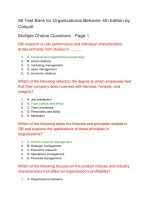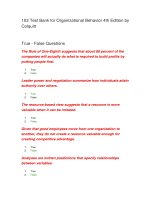Organizational behavior 4th by MShean chap002
Bạn đang xem bản rút gọn của tài liệu. Xem và tải ngay bản đầy đủ của tài liệu tại đây (344.69 KB, 30 trang )
2
Individual Behavior, Values,
and Personality
McGraw-Hill/Irwin
© 2008 The McGraw-Hill Companies, Inc. All rights reserved.
Engagement at Owens Corning
Owens Corning is making
employee engagement a
cornerstone of its
business strategy to
become a world-class
organization.
McShane/Von Glinow OB4e
Slide 2-2
Reprinted with permission of Owens Corning. All rights reserved
© 2008 The McGraw-Hill Companies, Inc. All rights reserved.
Employee Engagement Defined
The employee’s emotional
and cognitive (rational)
motivation, ability to perform
the job, clear understanding
of the organization’s vision
and his/her specific role in
that vision, and a belief that
he/she has the resources to
get the job done
McShane/Von Glinow OB4e
Slide 2-3
Reprinted with permission of Owens Corning. All rights reserved
© 2008 The McGraw-Hill Companies, Inc. All rights reserved.
MARS Model of Individual Behavior
Role
Perceptions
Values
Personality
Motivation
Individual
Behavior
and Results
Perceptions
Emotions
Attitudes
Ability
Situational
Factors
Stress
McShane/Von Glinow OB4e
Slide 2-4
© 2008 The McGraw-Hill Companies, Inc. All rights reserved.
Employee Motivation
• Internal forces that affect a person’s voluntary choice of
behavior. Motivational elements are:
– direction
– intensity
– persistence
M
R
BAR
A
McShane/Von Glinow OB4e
Slide 2-5
S
© 2008 The McGraw-Hill Companies, Inc. All rights reserved.
Employee Ability
• Natural aptitudes (natural talents) and learned
capabilities (skills and knowledge) required to
successfully complete a task
– competencies − personal characteristics that lead
to superior performance
– person − job matching
• selecting the best
• training & developing
• redesigning jobs
M
R
BAR
A
McShane/Von Glinow OB4e
Slide 2-6
S
© 2008 The McGraw-Hill Companies, Inc. All rights reserved.
Employee Role Perceptions
• Beliefs about what behavior is required to achieve the
desired results:
– understanding what tasks to perform
– understanding relative importance of tasks
– understanding preferred
behaviors to accomplish tasks
M
R
BAR
A
McShane/Von Glinow OB4e
Slide 2-7
S
© 2008 The McGraw-Hill Companies, Inc. All rights reserved.
Situational Factors
• Environmental conditions beyond the individual’s shortterm control that constrain or facilitate behavior.
Controllable factors are:
– time
– people
– budget
– work facilities
R
M
BAR
A
S
McShane/Von Glinow OB4e
Slide 2-8
© 2008 The McGraw-Hill Companies, Inc. All rights reserved.
Types of Behavior in Organizations
Task
Performance
Organizational
Citizenship
• Goal-directed behaviors under
person’s control
• Performance beyond the required
job duties
more
McShane/Von Glinow OB4e
Slide 2-9
© 2008 The McGraw-Hill Companies, Inc. All rights reserved.
Types of Behavior in Organizations
Counterproductive • Voluntary behavior that potentially
harms the organization
Work Behaviors
Joining/staying
with the
Organization
• Goal-directed behaviors under
person’s control
Maintaining Work •
Attending work at required times
Attendance
McShane/Von Glinow OB4e
Slide 2-10
© 2008 The McGraw-Hill Companies, Inc. All rights reserved.
Values in the Workplace
• Values are stable, evaluative beliefs that guide our
preferences for outcomes. A value is a principle, a
standard, or a quality considered worthwhile or
desirable.
• They define the right or wrong, good or bad
• Value system -- hierarchy of values
• Espoused vs. Enacted values:
– Espoused -- the values we say we use and often think we
use
– Enacted -- values we actually rely on to guide our decisions
and actions
McShane/Von Glinow OB4e
Slide 2-11
© 2008 The McGraw-Hill Companies, Inc. All rights reserved.
Three Categories of Values
• Personal values define who an individual is. They serve
as guides in handling situations and interacting with
others.
• Organizational values are the standards that guide an
individual's behavior in a professional context. They
define how an individual accomplishes work, interacts in
professional situations, and how he makes decisions
relative to his job/career.
• Cultural values are standards that guide how a person
relates meaningfully to others in different social
situations.
McShane/Von Glinow OB4e
Slide 2-12
© 2008 The McGraw-Hill Companies, Inc. All rights reserved.
Schwartz’s Values Model
Self-transcendence
Openness
to Change
Conservation
Self-enhancement
McShane/Von Glinow OB4e
Slide 2-13
© 2008 The McGraw-Hill Companies, Inc. All rights reserved.
Values and Behavior
•
•
Habitual behavior tends to be consistent with our
values, but our everyday conscious decisions and
actions apply our values much less consistently.
Decisions and behaviors linked to values when:43
1. Mindful and conscious of our values
2. Have logical reasons to apply values in that situation
3. Situation does not interfere
McShane/Von Glinow OB4e
Slide 2-14
© 2008 The McGraw-Hill Companies, Inc. All rights reserved.
Values Congruence at Coles
Integrity -- Respect/recognition -- Passion for excellence -- Working together
More than 2,300 Coles
employees across all levels
participated in 203 focus
groups around the country.
Their objective: to identify a
set of values for Australia’s
second largest retailer that
would be congruent with their
personal values.
Armen Dueschian/Newspix
McShane/Von Glinow OB4e
Slide 2-15
© 2008 The McGraw-Hill Companies, Inc. All rights reserved.
Values Congruence
• Values congruence -- where two
or more entities have similar
value systems
• Problems with incongruence
– Incompatible decisions
– Lower satisfaction and
commitment
– Increased stress and turnover
• Benefits of (some) incongruence
– Better decision making (diverse
values)
– Enhanced problem definition
– Prevents “corporate cults”
Armen Dueschian/Newspix
McShane/Von Glinow OB4e
Slide 2-16
© 2008 The McGraw-Hill Companies, Inc. All rights reserved.
Individualism- Collectivism
High
Peru
Italy
Collectivism
Portugal
Taiwan
Nigeria
PR China
India
Mexico
Hungary
Chile
Hong Kong
Korea
United States
France
Japan
New
Australia
Singapore
Zealand
Egypt
Low
Low
McShane/Von Glinow OB4e
Individualism
Slide 2-17
High
© 2008 The McGraw-Hill Companies, Inc. All rights reserved.
Power Distance
High Power Distance
Malaysia
Venezuela
Japan
The degree that
people accept an
unequal distribution
of power in society
U.S.
Denmark
Israel
Low Power Distance
McShane/Von Glinow OB4e
Slide 2-18
© 2008 The McGraw-Hill Companies, Inc. All rights reserved.
Uncertainty Avoidance
High U. A.
Greece
Japan
Italy
U.S.
The degree that people
tolerate ambiguity (low) or
feel threatened by
ambiguity and uncertainty
(high uncertainty
avoidance).
Singapore
Low U. A.
McShane/Von Glinow OB4e
Slide 2-19
© 2008 The McGraw-Hill Companies, Inc. All rights reserved.
Achievement-Nurturing
Achievement
Japan
The degree that people
value assertiveness,
competitiveness, and
materialism (achievement)
versus relationships and
well-being of others
(nurturing)
China
U.S.
France
Chile
Sweden
Nurturing
McShane/Von Glinow OB4e
Slide 2-20
© 2008 The McGraw-Hill Companies, Inc. All rights reserved.
Ethics
• Ethics is a system of moral values that govern a
person's conduct. Values and ethics, together, define a
person
• Ethics refers to the study of moral principles or values
that determine whether actions are right or wrong and
outcomes are good or bad.
• People rely on ethical values to determine ‘the right thing
to do’.
McShane/Von Glinow OB4e
Slide 2-21
© 2008 The McGraw-Hill Companies, Inc. All rights reserved.
Three Ethical Principles
Utilitarianism
Individual
Rights
Distributive
Justice
McShane/Von Glinow OB4e
Greatest good for the greatest
number of people
Fundamental entitlements
in society
People who are similar should
receive similar benefits
Slide 2-22
© 2008 The McGraw-Hill Companies, Inc. All rights reserved.
Influences on Ethical Conduct
• Moral intensity
– degree to which an issue demands the application of
ethical principles
• Ethical sensitivity
– ability to recognize the presence and determine the
relative importance of an ethical issue
• Situational influences
– competitive pressures and other conditions affect
ethical behavior
McShane/Von Glinow OB4e
Slide 2-23
© 2008 The McGraw-Hill Companies, Inc. All rights reserved.
Supporting Ethical Behavior
• Ethical code of conduct
– Establishes standards of behavior
– Problem: Limited effect alone on ethical behavior
• Ethics training
– Awareness and clarification of ethics code
– Practice resolving ethical dilemmas
• Ethics officers
– Educate and counsel; hear about wrongdoing
• Ethical leadership and culture
– Demonstrate integrity and role model ethical conduct
McShane/Von Glinow OB4e
Slide 2-24
© 2008 The McGraw-Hill Companies, Inc. All rights reserved.
Defining Personality
Relatively stable pattern of behaviors
and consistent internal states that
explain a person's behavioral
tendencies
McShane/Von Glinow OB4e
Slide 2-25
© 2008 The McGraw-Hill Companies, Inc. All rights reserved.









